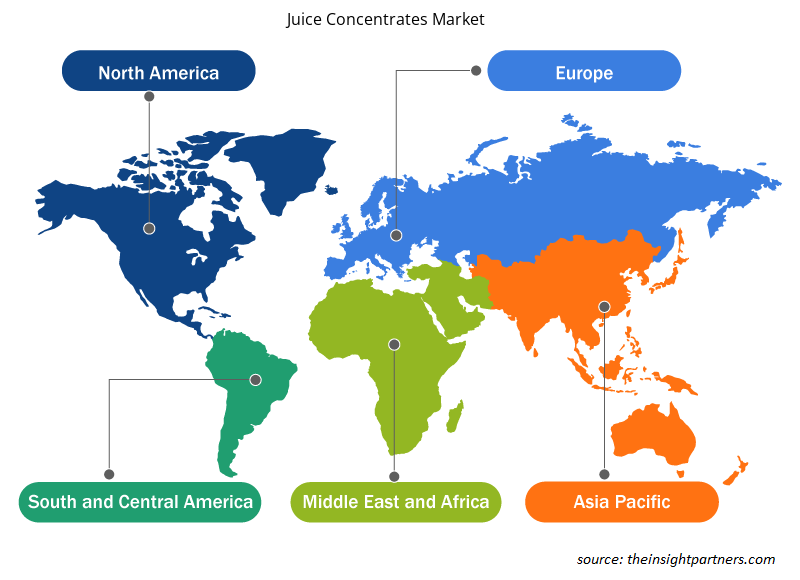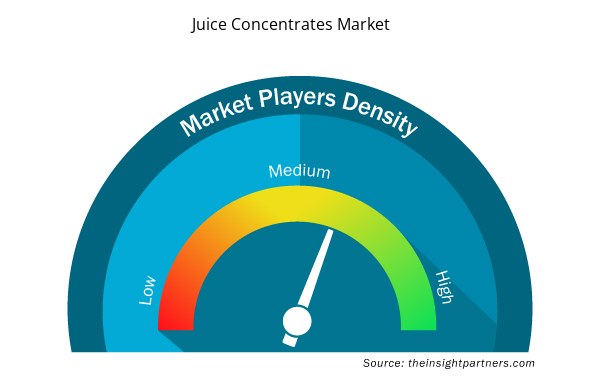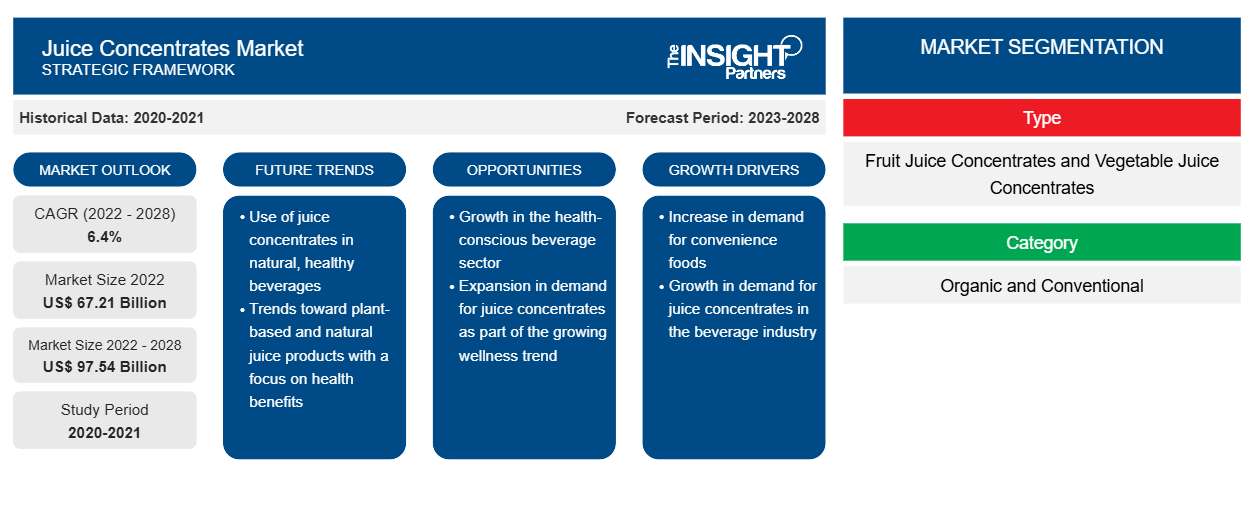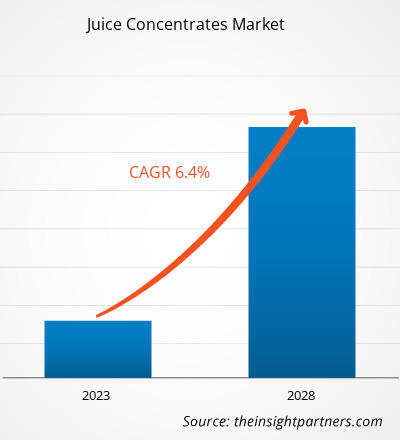Der Markt für Saftkonzentrate soll von 67.210,96 Millionen US-Dollar im Jahr 2022 auf 97.541,12 Millionen US-Dollar im Jahr 2028 wachsen; von 2022 bis 2028 wird eine durchschnittliche jährliche Wachstumsrate (CAGR) von 6,4 % erwartet.
Saftkonzentrate werden durch Entzug von Wasser aus Frucht- und Gemüsesäften hergestellt. Je nach Art der während des Prozesses verwendeten Früchte und Gemüse enthalten diese Konzentrate wichtige Nährstoffe wie Mineralien und Vitamine. Die Saftkonzentrate sind im Vergleich zu den Rohsäften stark verarbeitet. Das Wasser wird in Saftkonzentraten entzogen, da es das Bakterienwachstum reduziert. Die Saftkonzentrate werden im Allgemeinen bei Raumtemperatur gelagert oder eingefroren und dann vor dem Verzehr in gefiltertem Wasser verdünnt. Die Fruchtkonzentrate sind reich an Vitamin C und anderen Antioxidantien, die die Hautgesundheit fördern und die Auswirkungen der Hautalterung verlangsamen. Sie werden von Verbrauchern normalerweise als gesunde Alternative zu frisch gepresstem Saft konsumiert.
Im Jahr 2022 hielt Europa den größten Anteil am Markt für Saftkonzentrate . Der Markt im asiatisch-pazifischen Raum wird im Prognosezeitraum voraussichtlich mit der höchsten CAGR wachsen. Das Marktwachstum in Europa ist auf die Präsenz etablierter Akteure wie AGRANA Beteiligungs-AG, Archer Daniels Midland Company, Berrifine A/S, Ingredion Incorporated und Dohler GmbH zurückzuführen. Mit dem zunehmenden Gesundheitsbewusstsein der Verbraucher wird die Nachfrage nach natürlichen Produkten, die mit Saftkonzentraten hergestellt werden, im Prognosezeitraum voraussichtlich weiter steigen. Darüber hinaus steigt die Nachfrage nach unterwegs verfügbaren Fruchtgetränken aufgrund des hektischen Lebensstils der Verbraucher in der gesamten Region. Der steigende Konsum von Saftkonzentraten und Saftkonzentratprodukten wie Suppen und Soßen sowie Getränken ist auf die zunehmende Bevorzugung von Frucht- und Gemüsesäften gegenüber kohlensäurehaltigen Getränken zurückzuführen, insbesondere bei gesundheitsbewussten Verbrauchern.
Passen Sie diesen Bericht Ihren Anforderungen an
Sie erhalten kostenlose Anpassungen an jedem Bericht, einschließlich Teilen dieses Berichts oder einer Analyse auf Länderebene, eines Excel-Datenpakets sowie tolle Angebote und Rabatte für Start-ups und Universitäten.
- Holen Sie sich die wichtigsten Markttrends aus diesem Bericht.Dieses KOSTENLOSE Beispiel umfasst eine Datenanalyse von Markttrends bis hin zu Schätzungen und Prognosen.
Auswirkungen der COVID-19-Pandemie auf den Markt für Saftkonzentrate
Die COVID-19-Pandemie hat die Wirtschaft und Industrie in verschiedenen Ländern beeinflusst. Lockdowns, Reisebeschränkungen und Betriebsschließungen in Nordamerika, Europa, Asien-Pazifik (APAC), Süd- und Mittelamerika sowie dem Nahen Osten und Afrika (MEA) behinderten das Wachstum mehrerer Branchen, darunter auch der Lebensmittel- und Getränkeindustrie. Die Schließung von Produktionseinheiten unterbrach globale Lieferketten, Fertigungsaktivitäten, Lieferpläne sowie den Verkauf lebensnotwendiger und nicht lebensnotwendiger Produkte. Verschiedene Unternehmen erlebten im Jahr 2020 Verzögerungen bei der Produktlieferung und einen Einbruch der Verkäufe ihrer Produkte. Darüber hinaus zwangen die von den Regierungen verschiedener Länder in Europa, Asien-Pazifik und Nordamerika verhängten Reiseverbote die Unternehmen dazu, ihre Kooperations- und Partnerschaftspläne vorübergehend einzustellen. All diese Faktoren behinderten verschiedene Branchen im Jahr 2020 und Anfang 2021 und bremsten damit das Wachstum verschiedener Märkte, darunter auch des Marktes für Saftkonzentrate.
Vor dem Ausbruch der COVID-19-Pandemie war die Nachfrage nach Saftkonzentraten aufgrund des steigenden Bedarfs an Backwaren und der steigenden Produktion von Produkten mit verschiedenen Geschmacksrichtungen hoch. Nach dem Ausbruch der Pandemie im Jahr 2020 stand die verarbeitende Industrie jedoch vor beispiellosen Herausforderungen. Die Hersteller von Saftkonzentraten hatten aufgrund von Lieferkettenengpässen aufgrund landesweiter Ausgangssperren, Handelsverboten und Reisebeschränkungen mit vielen Problemen zu kämpfen. Die Unterbrechung der Lieferkette führte zur Lagerung von Rohstoffen, was die Produktion und den Vertrieb von Saftkonzentraten beeinträchtigte und zu höheren Preisen führte. Darüber hinaus gab es aufgrund der Ausgangssperren und Reisebeschränkungen eine enorme Lücke zwischen Angebot und Nachfrage.
Markteinblicke
Strategische Entwicklungen der wichtigsten Akteure begünstigen das Wachstum des Marktes für Saftkonzentrate im Prognosezeitraum
Im Mai 2022 errichtete die Austria Juice GmbH, ein Joint Venture zwischen AGRANA Beteiligungs-AG (AGRANA) und Raiffeisen Ware Austria AG (RWA), am Standort ihres Fruchtsaftkonzentratwerks in Kröllendorf, Oberösterreich, eine großflächige Photovoltaikanlage. An diesem Standort produziert das Unternehmen Fruchtsaftkonzentrate, Fruchtpürees und natürliche Aromen sowie Getränkegrundstoffe und Direktsäfte für den weiterverarbeitenden Getränkesektor. Solche strategischen Entwicklungen wichtiger Marktteilnehmer dürften das Wachstum des Marktes für Saftkonzentrate in den kommenden Jahren vorantreiben.
Typbasierte Erkenntnisse
Der Markt für Saftkonzentrate ist nach Typ in Fruchtsaftkonzentrate und Gemüsesaftkonzentrate unterteilt. Das Segment der Fruchtsaftkonzentrate hatte 2022 einen größeren Marktanteil, und das Segment der Gemüsesaftkonzentrate wird im Prognosezeitraum voraussichtlich eine höhere CAGR verzeichnen. Saftkonzentrat wird durch Extraktion von Wasser aus Fruchtsaft hergestellt und bietet einige wichtige Nährstoffe, darunter Vitamine und Mineralien. Durch Entfernen des Wassergehalts durch Verdampfung kann aus frischem Saft ein Saftkonzentrat werden, das als Aromastoff in anderen Lebensmittel- und Getränkeprodukten verwendet wird. Fruchtkonzentrate werden oft mit Wasser gemischt, um köstliche, erfrischende Saftgetränke herzustellen. Fruchtsaftkonzentrate werden hauptsächlich zur Herstellung von Fruchtsäften, Erfrischungsgetränken und Nektaren verwendet.
Kategorie-Einblicke
Der Markt für Saftkonzentrate ist nach Kategorien in Bio und Konventionell unterteilt. Das konventionelle Segment hatte 2022 einen größeren Marktanteil, und das Bio-Segment dürfte im Prognosezeitraum eine höhere durchschnittliche jährliche Wachstumsrate verzeichnen. Der konventionelle Anbau von Obst und Gemüse ermöglicht die Verwendung von Kunstdünger, Mist, Kompost, Klärschlamm und anderen Bodenverbesserungsmitteln. Obst und Gemüse der konventionellen Kategorie werden mit verschiedenen chemischen Düngemitteln, Pestiziden und Unkrautvernichtungsmitteln besprüht und es werden künstliche Methoden wie gentechnisch veränderte Organismen angewendet. Infolgedessen ist der konventionelle Anbau billiger als der ökologische. Daher sind konventionelle Saftkonzentrate billiger als Bio-Säfte.
Formularbasierte Erkenntnisse
Der Markt für Saftkonzentrate ist nach Form in Pulver und Flüssigkeit unterteilt. Das Flüssigsegment hatte 2022 einen größeren Marktanteil, und das Pulversegment dürfte im Prognosezeitraum eine höhere CAGR verzeichnen. Lösungsmittel aus Obst und Gemüse sowie der gewonnene Pflanzenextrakt sind in flüssiger Form erhältlich. Dieser flüssige Extrakt kann weiter zu Pulver verarbeitet oder in den Endverbrauchsindustrien für verschiedene Anwendungen vertrieben werden. Die flüssige Form ist die am häufigsten erhältliche Form von Saftkonzentrat, da sie im Vergleich zu anderen Formen nur minimal verarbeitet werden muss.
Anwendungseinblicke
Basierend auf der Anwendung ist der Markt für Saftkonzentrate in Backwaren und Süßwaren, Getränke, Suppen, Saucen und Gewürze, Milchprodukte und gefrorene Desserts und andere unterteilt. Das Getränkesegment hatte 2022 den größten Marktanteil, und das Backwaren- und Süßwarensegment wird im Prognosezeitraum voraussichtlich die höchste durchschnittliche jährliche Wachstumsrate verzeichnen. Saftkonzentrate werden häufig zur Herstellung von Bio- und konventionellen Getränken wie Wasser plus, Fruchtspritzern, kohlensäurehaltigen Erfrischungsgetränken, Teegetränken, Biermischgetränken, Apfelwein und Spirituosen verwendet, was das Wachstum des Getränkesegments ankurbelt. Dieses Wachstum wird auch durch die steigende Nachfrage nach immunitätssteigernden, gesunden und funktionellen Getränken unterstützt. Einige große Getränkehersteller wie Döhler haben mehrere Produkte angeboten, darunter CO2-stabile Konzentrate, geklärte Saftkonzentrate und alkoholstabile Saftkonzentrate.
Ciatti Co, Berrifine AS, Archer-Daniels-Midland Co, AGRANA Beteiligungs AG, Dohler GmbH, Kanegrade Ltd, CitroGlobe SRL, SVZ International BV und IPRONA SpA gehören zu den wichtigsten Akteuren auf dem Markt für Saftkonzentrate. Diese Unternehmen konzentrieren sich hauptsächlich auf Produktinnovationen, um ihre Marktgröße zu erweitern und aufkommende Trends zu verfolgen.
Regionale Einblicke in den Markt für Saftkonzentrate
Die regionalen Trends und Faktoren, die den Markt für Saftkonzentrate im Prognosezeitraum beeinflussen, wurden von den Analysten von Insight Partners ausführlich erläutert. In diesem Abschnitt werden auch die Marktsegmente und die Geografie von Saftkonzentraten in Nordamerika, Europa, im asiatisch-pazifischen Raum, im Nahen Osten und Afrika sowie in Süd- und Mittelamerika erörtert.

- Holen Sie sich die regionalen Daten für den Markt für Saftkonzentrate
Umfang des Marktberichts über Saftkonzentrate
| Berichtsattribut | Details |
|---|---|
| Marktgröße im Jahr 2022 | 67,21 Milliarden US-Dollar |
| Marktgröße bis 2028 | 97,54 Milliarden US-Dollar |
| Globale CAGR (2022 - 2028) | 6,4 % |
| Historische Daten | 2020-2021 |
| Prognosezeitraum | 2023–2028 |
| Abgedeckte Segmente | Nach Typ
|
| Abgedeckte Regionen und Länder | Nordamerika
|
| Marktführer und wichtige Unternehmensprofile |
|
Dichte der Marktteilnehmer für Saftkonzentrate: Deren Auswirkungen auf die Geschäftsdynamik verstehen
Der Markt für Saftkonzentrate wächst rasant, angetrieben durch die steigende Endverbrauchernachfrage aufgrund von Faktoren wie sich entwickelnden Verbraucherpräferenzen, technologischen Fortschritten und einem größeren Bewusstsein für die Vorteile des Produkts. Mit steigender Nachfrage erweitern Unternehmen ihr Angebot, entwickeln Innovationen, um die Bedürfnisse der Verbraucher zu erfüllen, und nutzen neue Trends, was das Marktwachstum weiter ankurbelt.
Die Marktteilnehmerdichte bezieht sich auf die Verteilung von Firmen oder Unternehmen, die in einem bestimmten Markt oder einer bestimmten Branche tätig sind. Sie gibt an, wie viele Wettbewerber (Marktteilnehmer) in einem bestimmten Marktraum im Verhältnis zu seiner Größe oder seinem gesamten Marktwert präsent sind.
Die wichtigsten auf dem Markt für Saftkonzentrate tätigen Unternehmen sind:
- AGRANA Beteiligungs AG
- Archer-Daniels-Midland Co
- Berrifine AS
- Ciatti Co
- Dohler GmbH
Haftungsausschluss : Die oben aufgeführten Unternehmen sind nicht in einer bestimmten Reihenfolge aufgeführt.

- Überblick über die wichtigsten Akteure auf dem Markt für Saftkonzentrate
Bericht-Spotlights
- Fortschrittliche Branchentrends im Markt für Saftkonzentrate helfen Unternehmen bei der Entwicklung wirksamer langfristiger Strategien
- Von Marktteilnehmern in Industrie- und Entwicklungsländern verfolgte Strategien für Unternehmenswachstum
- Quantitative Analyse des Marktes von 2022 bis 2028
- Schätzung der weltweiten Nachfrage nach Saftkonzentraten
- Porters Fünf-Kräfte-Analyse zur Veranschaulichung der Wirksamkeit von Käufern und Lieferanten auf dem Markt für Saftkonzentrate
- Aktuelle Entwicklungen zum Verständnis des wettbewerbsorientierten Marktszenarios
- Markttrends und -aussichten sowie Wachstumstreiber und -hemmnisse im Markt für Saftkonzentrate
- Unterstützung im Entscheidungsprozess durch Aufzeigen von Marktstrategien, die das kommerzielle Interesse untermauern
- Größe des Marktes für Saftkonzentrate an verschiedenen Knotenpunkten
- Detaillierte Übersicht und Segmentierung des Marktes und der Wachstumsdynamik der Saftkonzentratindustrie
- Größe des Marktes für Saftkonzentrate in verschiedenen Regionen mit vielversprechenden Wachstumschancen
- Historische Analyse (2 Jahre), Basisjahr, Prognose (7 Jahre) mit CAGR
- PEST- und SWOT-Analyse
- Marktgröße Wert/Volumen – Global, Regional, Land
- Branche und Wettbewerbsumfeld
- Excel-Datensatz



Report Coverage
Revenue forecast, Company Analysis, Industry landscape, Growth factors, and Trends

Segment Covered
This text is related
to segments covered.

Regional Scope
North America, Europe, Asia Pacific, Middle East & Africa, South & Central America

Country Scope
This text is related
to country scope.
Häufig gestellte Fragen
Increasing demand for natural food products is driving the juice concentrates market. Juices are considered as a healthy alternative to carbonated drinks, which in turn aids the juice concentrates market growth in the upcoming years. Juice concentrates are again proving to be a healthy option as they are enhanced with some of the essential minerals with nutrients that are necessary by the human body. Due to the hectic lifestyle of working-class consumers and change in consumer lifestyle, people body lacks nutrients along with antioxidants which aid in dealing with various hair, heart, skin, and other health-associated problems. Due to these factors, there is a rise in demand for juice concentrates since this juice concentrates consists of the minerals & nutrients required by consumers' body.
Based on the application, bakery & confectionery segment is projected to grow at the fastest CAGR over the forecast period. Juice concentrates are often used in the bakery and confectionery industry as a sweetener, or colorant. Fruit concentrates are also finding its application as an icing to decorate cakes, pastries, and muffins. The juice concentrates essentially thrive on the wider functional & nutritional benefits that fruits & vegetables concentrates confer in terms of the high quality, safety, and nutrition of processed food products. Further, it is used in the manufacturing of chocolates and milk candies. Organic juice concentrates have various nutritional benefits because manufacturers use them as a raw material for their products. The demand for juice concentrates is rapidly growing across the food sector. The food & confectionery segment is a prominent application segment for juice concentrates due to the rising consumption of healthy nutritional enriched products.
Based on type, fruit concentrates segments mainly have the largest revenue share. Fruit juice concentrates are majorly use for making fruit juices, soft drinks, and nectars. Fruit juice concentrate has been associated with a variety of health benefits and is widely applicable in food & beverage industry in making bakery & confectionery products, beverages, soups, sauces, & condiments, and dairy & frozen dessert. Fruit juice concentrate is being sold in powdered or liquid form for mixing into food products. Also, can be easily transported and stored. Thus, the factors mentioned above are driving the fruit juice concentrate segments’ growth.
Europe accounted for the largest share of the global juice concentrates market. Juice concentrates have been gaining popularity in Europe due to its extensive usage as a substitute for sweets in the bakery & confectionery industry. The rising consumption of juice concentrates and juice concentrates products such as soups & sauces and beverages is due to the growing adoption of fruit and vegetable juices over aerated drinks, especially by health-conscious consumers. Fruits and vegetables are the key products of the European Union agricultural products. The demand for fruits & vegetables also supports the growth of the juice concentrates market in the region.
The major players operating in the global juice concentrates market are AGRANA Beteiligungs AG, Archer-Daniels-Midland Co, Berrifine AS, Ciatti Co, Dohler GmbH, Ingredion Inc, Kanegrade Ltd, CitroGlobe SRL, SVZ International BV, IPRONA SpA.
Strategic developments by key market players to provide potential market opportunities in the coming years for the juice concentrates. The rising consumer preference and demand for nutrient-rich, premium, and personalized flavors has increased product innovations. Manufacturers in the market are adding functional components such as vitamins, fortified concentrates, and other to juice concentrates, in order to enhance the nutritional quality of the product. In addition, the consumers are more inclined towards adoption of organic, natural and clean-labelled products. This has surged the manufacturers to develop organic and clean labelled products in order to cater the growing consumer demand.
Trends and growth analysis reports related to Food and Beverages : READ MORE..
The List of Companies - Juice Concentrates Market
- AGRANA Beteiligungs AG
- Archer-Daniels-Midland Co
- Berrifine AS
- Ciatti Co
- Dohler GmbH
- Ingredion Inc
- Kanegrade Ltd
- CitroGlobe SRL
- SVZ International BV
- IPRONA SpA
The Insight Partners performs research in 4 major stages: Data Collection & Secondary Research, Primary Research, Data Analysis and Data Triangulation & Final Review.
- Data Collection and Secondary Research:
As a market research and consulting firm operating from a decade, we have published and advised several client across the globe. First step for any study will start with an assessment of currently available data and insights from existing reports. Further, historical and current market information is collected from Investor Presentations, Annual Reports, SEC Filings, etc., and other information related to company’s performance and market positioning are gathered from Paid Databases (Factiva, Hoovers, and Reuters) and various other publications available in public domain.
Several associations trade associates, technical forums, institutes, societies and organization are accessed to gain technical as well as market related insights through their publications such as research papers, blogs and press releases related to the studies are referred to get cues about the market. Further, white papers, journals, magazines, and other news articles published in last 3 years are scrutinized and analyzed to understand the current market trends.
- Primary Research:
The primarily interview analysis comprise of data obtained from industry participants interview and answers to survey questions gathered by in-house primary team.
For primary research, interviews are conducted with industry experts/CEOs/Marketing Managers/VPs/Subject Matter Experts from both demand and supply side to get a 360-degree view of the market. The primary team conducts several interviews based on the complexity of the markets to understand the various market trends and dynamics which makes research more credible and precise.
A typical research interview fulfils the following functions:
- Provides first-hand information on the market size, market trends, growth trends, competitive landscape, and outlook
- Validates and strengthens in-house secondary research findings
- Develops the analysis team’s expertise and market understanding
Primary research involves email interactions and telephone interviews for each market, category, segment, and sub-segment across geographies. The participants who typically take part in such a process include, but are not limited to:
- Industry participants: VPs, business development managers, market intelligence managers and national sales managers
- Outside experts: Valuation experts, research analysts and key opinion leaders specializing in the electronics and semiconductor industry.
Below is the breakup of our primary respondents by company, designation, and region:

Once we receive the confirmation from primary research sources or primary respondents, we finalize the base year market estimation and forecast the data as per the macroeconomic and microeconomic factors assessed during data collection.
- Data Analysis:
Once data is validated through both secondary as well as primary respondents, we finalize the market estimations by hypothesis formulation and factor analysis at regional and country level.
- Macro-Economic Factor Analysis:
We analyse macroeconomic indicators such the gross domestic product (GDP), increase in the demand for goods and services across industries, technological advancement, regional economic growth, governmental policies, the influence of COVID-19, PEST analysis, and other aspects. This analysis aids in setting benchmarks for various nations/regions and approximating market splits. Additionally, the general trend of the aforementioned components aid in determining the market's development possibilities.
- Country Level Data:
Various factors that are especially aligned to the country are taken into account to determine the market size for a certain area and country, including the presence of vendors, such as headquarters and offices, the country's GDP, demand patterns, and industry growth. To comprehend the market dynamics for the nation, a number of growth variables, inhibitors, application areas, and current market trends are researched. The aforementioned elements aid in determining the country's overall market's growth potential.
- Company Profile:
The “Table of Contents” is formulated by listing and analyzing more than 25 - 30 companies operating in the market ecosystem across geographies. However, we profile only 10 companies as a standard practice in our syndicate reports. These 10 companies comprise leading, emerging, and regional players. Nonetheless, our analysis is not restricted to the 10 listed companies, we also analyze other companies present in the market to develop a holistic view and understand the prevailing trends. The “Company Profiles” section in the report covers key facts, business description, products & services, financial information, SWOT analysis, and key developments. The financial information presented is extracted from the annual reports and official documents of the publicly listed companies. Upon collecting the information for the sections of respective companies, we verify them via various primary sources and then compile the data in respective company profiles. The company level information helps us in deriving the base number as well as in forecasting the market size.
- Developing Base Number:
Aggregation of sales statistics (2020-2022) and macro-economic factor, and other secondary and primary research insights are utilized to arrive at base number and related market shares for 2022. The data gaps are identified in this step and relevant market data is analyzed, collected from paid primary interviews or databases. On finalizing the base year market size, forecasts are developed on the basis of macro-economic, industry and market growth factors and company level analysis.
- Data Triangulation and Final Review:
The market findings and base year market size calculations are validated from supply as well as demand side. Demand side validations are based on macro-economic factor analysis and benchmarks for respective regions and countries. In case of supply side validations, revenues of major companies are estimated (in case not available) based on industry benchmark, approximate number of employees, product portfolio, and primary interviews revenues are gathered. Further revenue from target product/service segment is assessed to avoid overshooting of market statistics. In case of heavy deviations between supply and demand side values, all thes steps are repeated to achieve synchronization.
We follow an iterative model, wherein we share our research findings with Subject Matter Experts (SME’s) and Key Opinion Leaders (KOLs) until consensus view of the market is not formulated – this model negates any drastic deviation in the opinions of experts. Only validated and universally acceptable research findings are quoted in our reports.
We have important check points that we use to validate our research findings – which we call – data triangulation, where we validate the information, we generate from secondary sources with primary interviews and then we re-validate with our internal data bases and Subject matter experts. This comprehensive model enables us to deliver high quality, reliable data in shortest possible time.


 Holen Sie sich ein kostenloses Muster für diesen Bericht
Holen Sie sich ein kostenloses Muster für diesen Bericht